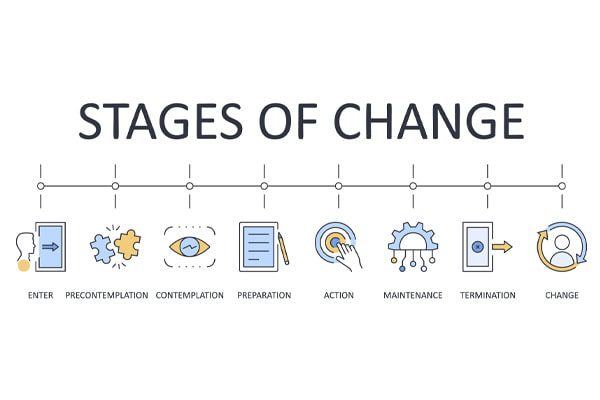The Stages of Change Model, also known as the Transtheoretical Model of Behavior Change, is a powerful framework designed to explain and guide individuals through the process of behavior change.
Developed by James O. Prochaska and Carlo C. DiClemente, this model has become a cornerstone in health psychology and is widely used in healthcare and wellness programs.
To learn how to apply this model to your work, we’ll review the six stages of change, what interventions look like at each stage, and some techniques to incorporate this model into your practice.
The stages in the Stages of Change Model

The Stages of Change Model contains six distinct stages which individuals pass through on their way to behavior change. This is not a “checklist” of how to encourage change within your clients or yourself, but rather a way of thinking about the psychology of changing habits. This model can be used to help clients to overcome addictive behaviors, changes in health routines, and so much more.
The stages of this model, and how providers can help at each stage, include the following:
Pre-contemplation
In this stage, individuals are not yet considering a change in behavior. They may be unaware of the need for change or resistant to the idea.
The best way to help your client at this stage is to accept their resistance and respond with empathy and active listening. If you push too hard in this stage, the client may become defensive and unwilling to seek further help.
Contemplation
At this point, individuals recognize the need for change and are contemplating the possibility of acting. However, they may lack the confidence to initiate the change process.
As a provider, you can help your client weigh the pros and cons of action versus inaction, get to know their beliefs (both about the world and self), and ask about any barriers they’re facing. This way, you gain a deeper understanding of your client’s thinking and the issues they face (e.g., lack of self-esteem, social barriers, etc.).
Preparation
Individuals in the preparation stage are ready to act and have begun making small changes. They may be gathering information and developing a plan to implement change.
To help your clients in this stage, work with them to develop small, achievable goals that lead to the change they want to affect. You can also help them plan for pitfalls and what to do if they encounter them.
Action
This stage involves the implementation of the actual behavior change. Individuals are actively modifying their behaviors, environment, or both to achieve their desired outcome.
Supporting your clients in this stage means conducting periodic reviews with them to measure their confidence, motivation, and progress. Make sure they have access to the resources they need and help guide them through any rough patches.
Maintenance
Once the behavior change has been successfully implemented, the focus shifts to maintaining the new behavior. A client is considered to be in the maintenance stage once they’ve demonstrated the desired behavior for six months. People will typically remain in this stage for five years as they build the new behavior into their lives.
At this stage, your role will simply be to help the client maintain their progress on an as-needed basis. Most interventions here involve preventing relapses into negative behavior or helping clients deal with the psychological toll of relapse.
Termination
When an individual enters the termination stage, they have no desire to return to their old behavior. Depending on the behavior the individual is attempting to change, this stage may or may not be reachable.
How to use the Stages of Change in your practice

While the ways in which you choose to help your client will depend on which stage of change they are in, consider these strategies for integrating this model into your practice.
Individualized care plans
One of the ways your organization can leverage the Stages of Change Model is by developing individualized care plans based on the client’s stage of change. Recognizing that individuals progress through various stages at their own pace, you can tailor interventions to meet the specific needs and readiness of each client. For instance, a client in the precontemplation stage may benefit from awareness-building strategies, while someone in the preparation stage may require more concrete action-oriented plans.
Establish open lines of communication
Effective communication is essential in behavioral health, and understanding the Stages of Change can significantly improve client-provider interactions. By acknowledging and respecting the client’s current stage, behavioral health professionals can adopt appropriate communication strategies. Motivational interviewing, a technique aligned with the Stages of Change, can be particularly beneficial in eliciting clients’ motivations and enhancing their commitment to change.
Prevention and early intervention
Organizations can proactively incorporate the Stages of Change Model into prevention, intervention, and cessation programs. By identifying individuals in the precontemplation or contemplation stages, you can intervene early, offering support and resources before issues escalate.
Monitoring progress and adjusting interventions
Regularly assessing clients’ progress through the stages of change allows you to adapt interventions as needed. This dynamic approach ensures that the care provided remains aligned with the client’s evolving readiness for change. Monitoring progress also enables you to recognize and address potential barriers or setbacks, fostering long-term success in behavior change.






